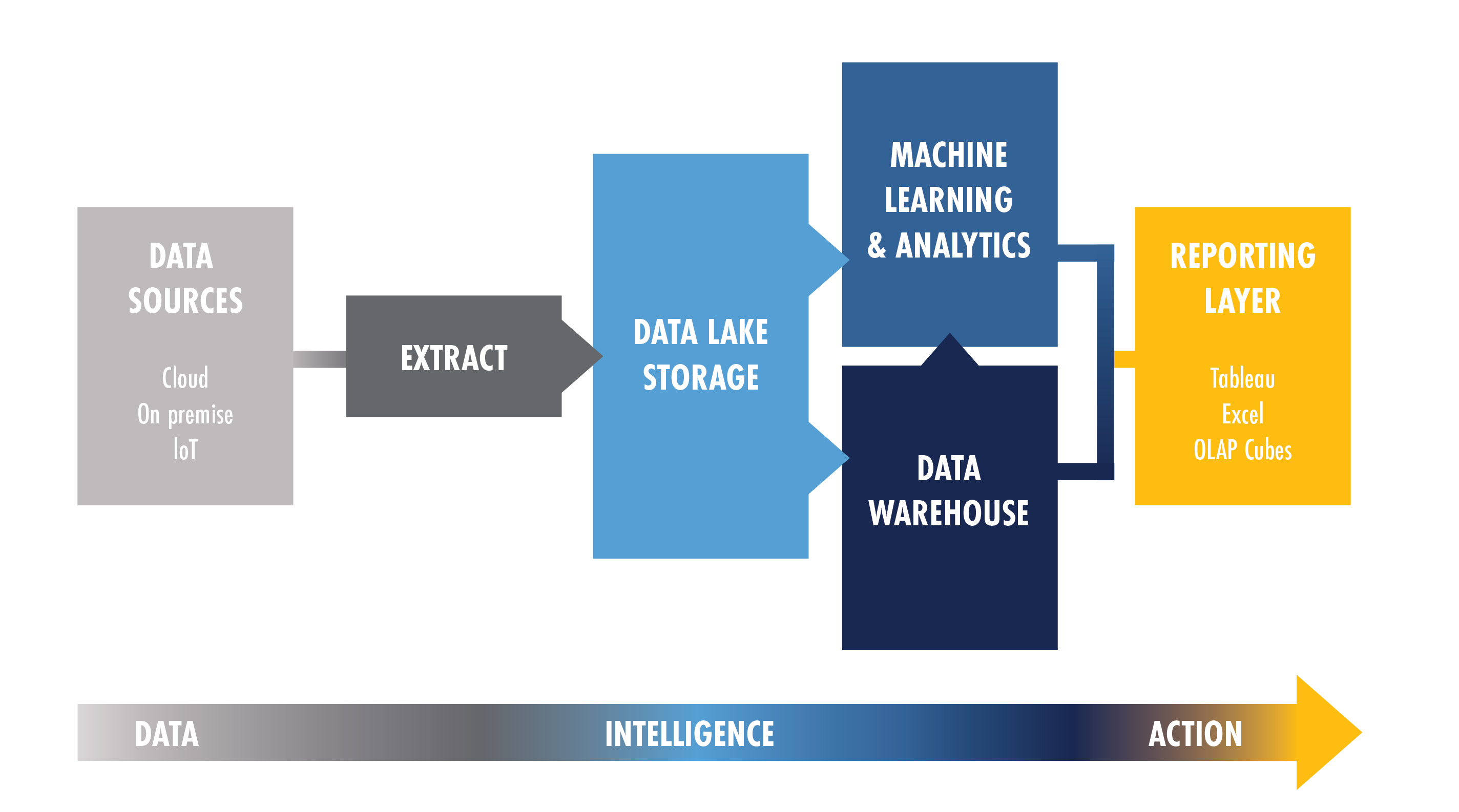Strategies to Become a Data-Driven Company

Industry 4.0 solutions don’t just enhance efficiency and productivity; they provide opportunities for manufacturers to gain insight into operations at a granular level. Data gathered from all levels of operations—production, inventory, equipment, supply chain, sales, and finance—can be measured and leveraged to optimize manufacturing operations. However, many manufacturers lack the technology to easily access and analyze their data.
Creating an environment that allows you to collect, process, and turn data into actionable insight requires a digital-first focus. This allows manufacturers to make more accurate and informed business decisions.
Here’s how manufacturers can move to the forefront of Industry 4.0 by leveraging data analytics.

The journey your raw data takes to become actionable is complex. But you don’t have to be a data scientist to make the most out of your data.
Ultimately, data analytics has three critical components:
- Capturing the data
- Analyzing the data
- Using the data
Capturing the Data
The first step in being able to use your data to drive decisions is in the collection of your data. Here is a sampling of data manufacturers can capture:
Machine and Equipment Data: Small remote sensors in Internet of Things (IoT) devices capture equipment information on uptime and downtime, maintenance schedules, performance, temperature, and more.
Production Data: Visibility into the quantity and quality of your output, the time it takes to produce your product, production line uptime and downtime, and scrap and rework rates can help you streamline your processes to improve efficiency and identify bottlenecks.
Inventory Data: Data on finished goods inventory levels, turnover rates, and stockouts can be used to better manage your warehouse and forecast future trends.
Supply Chain Data: Vendor and partner data such as supplier performance, lead times, and delivery times can help you make better decisions about materials ordering and consumption.
Workforce Data: Workforce data gives manufacturers valuable insight into labor productivity and personnel costs at each stage of production for better decision making.
Customer Data: Marketing and sales channels constantly capture information from customer relationship management (CRM) platforms, ordering and fulfillment software, social media, website benchmarks, and more, giving you an opportunity to enhance the customer experience.
Financial Data: Data such as revenue, cost of goods sold, gross profit margins, and operating expenses can be used to help you formulate strategic plans and see into the financial health of your company.
Analyzing the Data
Disparate systems used in manufacturing operations create data silos. By pulling and centralizing data into a data warehouse, all the data you collect, including sales, accounting and inventory data, is synthesized into a single source of truth that every department can access. This eliminates data silos and results in more accurate reporting.
Data analysis then takes the data from your data warehouse and uses computational algorithms, including artificial intelligence (AI), to identify problems. Visualizations of the data help you understand the current state of your organization and are designed to lead your team to action.
The key to gaining actionable insight from your data is identifying the most valuable KPIs for your company. If your KPIs are not tied to your overall business objectives, your reports won’t drive change.
The KPIs for your finance or HR department differ from those for production. Your finance team likely needs net operating profit, liquidity ratio, and return on asset reports, while HR is more interested in turnover, compensation, or time to fill positions. Critical metrics for production may be cycle time, production yield, or customer return rate. Insight into your equipment will come from tracking OEE and downtime.
At the end of the day, your KPIs should be driven by your strategic objectives. For this reason, company leadership must be at the helm any time there is a data and technology initiative.
Using the Data
After collecting your data and turning it into something everyone can understand, it’s time to turn insight into action. Consider a consumer goods manufacturer operating in a highly competitive landscape. They want to increase production capacity and reduce production costs as part of their strategic operating plan for the upcoming year.
By looking at production data such as OEE, machine downtime, cycle time, and production yield, leaders can identify bottlenecks that slow production down and limit capacity. They can dive into supply chain data such as performance, lead times, delivery times, and material cost to explore ways to increase efficiency in their processes. With the help of AI, they can use predictive analytics and what-if scenarios to gain insight into different courses of action.
These actions may include:
- Investing in new equipment that is faster and more efficient.
- Optimizing their supply chain by standardizing their processes, diversifying their network, and negotiating a better price with suppliers.
- Automating tedious and manual processes so employees can engage in higher-value work
- Reducing waste and increasing recyclables.
- Changing their Electronic Data Interchange (EDI) from a price-per-document model to a license-based model.
Ultimately, the manufacturers that use real-time data to drive strategic decisions will lead Industry 4.0.
Becoming a Data-Driven Manufacturer
Becoming data driven starts with strategy. It’s time to review your data strategy if:
- Your organization has no defined data strategy.
- It has been more than five years since you have updated your data strategy or reviewed your data points for vulnerabilities.
- There has been a change in leadership at your organization, particularly in financial, operating, or technology roles.
- You have merger and acquisition activity at your organization.
- You are looking to make investments in technology and analytics.
Your strategy is unique to your organization. Getting it right means having accurate, real-time data across applications that you can rely on.
In short, better data drives better business decisions. When manufacturers align their business goals with their data, they gain valuable insight that keeps them agile and at the forefront of their industry. By leveraging real-time information, manufacturers can make stronger tactical and strategic decisions.

